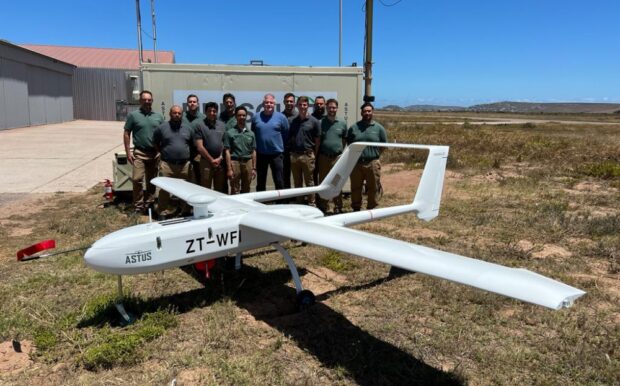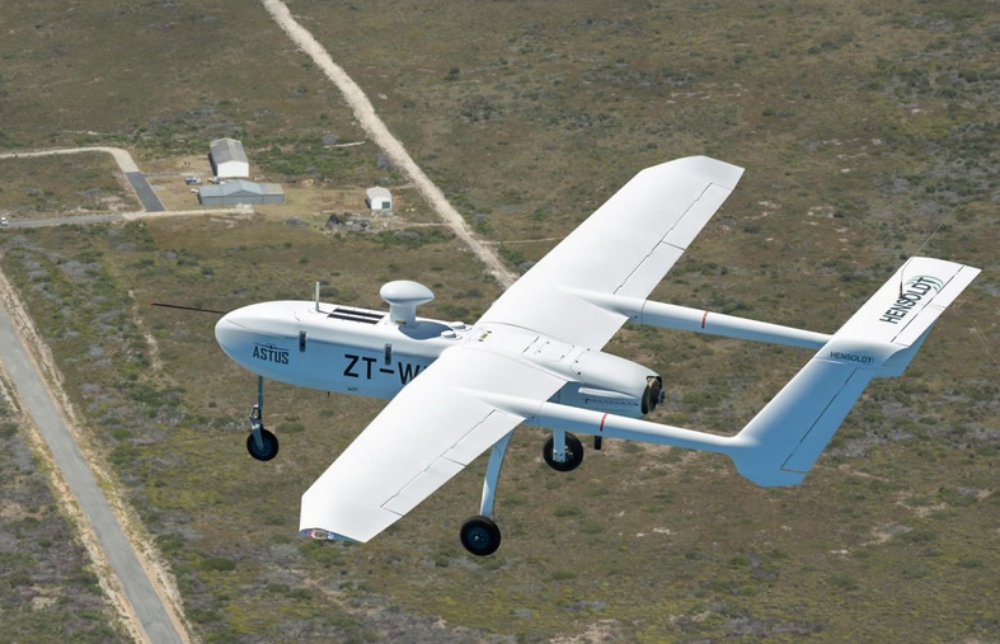recently held flight demonstrations of its Astus unmanned aerial vehicle (UAV) in the Western Cape for potential customers, and showcasing the capabilities of the aircraft’s various sensor payloads.
Demonstration flights began on 24 November and continued for aweek at Saldanha on the Cape west coast. Two UAVs are flying, one fitted with an Epsilon 180 gimbal and the other with a Hensoldt XTP 30 training gimbal. The Epsilon 180 from Octopus ISR Systems weighs 5 kg and features a full HD electro-optical, mid-wave infrared, laser range finder and laser pointer (EO/MWIR/LRF/LP) payload.
During demonstration flights, the 30 x optical zoom camera was able to track a golf ball being played at a local golf course from 2.5 kilometres away, and could clearly reveal the name painted on the side of a ship 10.5 kilometres out to sea. The MWIR sensor has 15 x optical zoom while the laser range finder has a 20 km measuring range.
Hensoldt South Africa and Threod Systems recently launched the new light-weight electro optical Argos-8 system, weighing less than 6 kg and offering day and night capabilities for intelligence, surveillance, target acquisition, and reconnaissance (ISTAR) missions. This will be fitted to the Astus early next year.
Willie Malan, Manager Unmanned Systems at Hensoldt Optronics, emphasised that while the Astus is a capable platform, its key attribute is its sensor payload. Artificial intelligence and imaging technology have improved tremendously in recent years, and this is what Hensoldt is really highlighting with the Astus demonstration. Malan said the 8-inch gimbal’s auto tracker was able to detect moving targets – such as sheep walking through a field – and track vehicles moving through bush.
Various flight profiles are being flown around Saldanha, out to ranges of more than 100 kilometres, and altitudes of up to 16 000 feet (maximum communications range is 200 km). The aircraft is demonstrating its utility in roles from traffic monitoring to maritime surveillance, fisheries patrol, counter-poaching etc.
Numerous local and international potential customers are attending the demonstration, including several “serious prospective buyers.” Attendees are from both civil and military institutions, including non-governmental organisations and city councils. Other flight demonstrations will take place early next year.
Malan said that the Astus airframe is production ready, and basic gimbals integrated, but Hensoldt is working on adding more and different sensors to the airframe.
In addition to the customer demonstrations and payload development flights, the Astus deployment to Saldanha is also assessing the use of a logistical support container for spare parts supply in the field. Over the last few years of testing the Astus team deployed with a large staff component as part of initial development but for this mission the team was cut down to only the minimum five staff needed.
The Astus was first unveiled in September 2018, by Tellumat, and was subsequently acquired by Hensoldt South Africa along with some of Tellumat’s other business units. Key features of the medium-size, medium-range UAV are a 5.2-metre wingspan, 115 kg maximum take-off weight; eight hours flight time at 5 000 feet above sea level; and cruising speed of 55-60 knots. The aircraft can carry payloads up to 10 kg.
The modular and portable ground control station (GCS) can be networked to allow control of the Astus by more than one pilot and payload operator geographically separated across the mission area. It consists of an operator control unit (OCU) and ground data terminal (GDT) that offer flight and mission control management of the Astus.
Source: DefenceWeb


